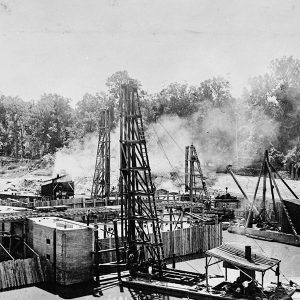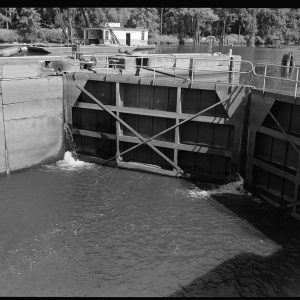calsfoundation@cals.org
Calion (Union County)
| Latitude and Longitude | 33°19’44″N 092°32’19″W |
| Elevation: | 92 feet |
| Area: | 1.07 square miles (2020 Census) |
| Population: | 429 (2020 Census) |
| Incorporation Date: | January 4, 1921 |
Historical Population as per the U.S. Census:
|
1810 |
1820 |
1830 |
1840 |
1850 |
1860 |
1870 |
1880 |
1890 |
1900 |
|
– |
– |
– |
– |
– |
– |
– |
– |
– |
– |
|
1910 |
1920 |
1930 |
1940 |
1950 |
1960 |
1970 |
1980 |
1990 |
2000 |
|
– |
– |
924 |
712 |
536 |
544 |
535 |
638 |
558 |
516 |
|
2010 |
2020 |
|
|
|
|
|
|
|
|
|
494 |
429 |
|
|
|
|
|
|
|
|
Calion is a second-class city in the northern part of Union County, on Highway 167 and on the south bank of the Ouachita River. The city is known principally as a timber industry center, although increasing emphasis is being placed on tourism opportunities associated with Lake Calion. The African American neighborhood of Jelly Roll in Calion was the subject of an anthropological study published in 1986.
Native American artifacts of the prehistoric era—including Koroa and prehistoric Caddo—have been discovered across the river from Calion in southern Calhoun County. Some historians have attempted to demonstrate that Hernando de Soto’s expedition wintered in that region, since it is known that the expedition did travel along the Ouachita River. In the nineteenth century, the land that would become Calion was a steamboat stop called El Dorado Landing. Until railroads reduced the need for river traffic, El Dorado Landing was a frequent stopping point for packets en route to Camden (Ouachita County) and Arkadelphia (Clark County). Heavy timber and swampland made the land unattractive to settlers.
In 1903, a railroad bridge was constructed by the Little Rock Southern Railway (later part of the Chicago, Rock Island, and Pacific Railroad) to cross the Ouachita River at the location of the old steamboat port. A sawmill was constructed by a man with the last name of Thomas in 1916, the same year that the U.S. Army Corps of Engineers completed Ouachita River Lock and Dam Number Eight. A community rapidly grew around the lock and dam and the sawmill. When the city was incorporated in 1921, the name Calion was created from the first three letters of Calhoun County and the last three letters of Union County. In spite of the lock and dam, river flooding was frequent; during the Flood of 1927, logs and planks from the sawmill were washed into many portions of Louisiana.
A highway connecting Benton (Saline County) with El Dorado (Union County) was completed in 1930 and included a bridge crossing the Ouachita River at Calion. This bridge is now on the National Register of Historic Places. Calion’s Shipping Terminal and Docks, completed in 1932, enhanced the role of the city as a transportation hub on the river. Thomas’s sawmill, with its lumber yard and furniture parts factory, remained the city’s principal employer. Unemployment was high during the Great Depression when the business had to cut back on production. Jobs returned after World War II, as the city developed around two neighborhoods: a Black community called Jelly Roll, located on two blocks near the sawmill entrance, and a white community situated a bit farther away from the sawmill. Charles E. Thomas, grandson of the founder of the sawmill, wrote a study on the Jelly Roll community that was published in 1986. In it, he described the eighty-four households of Jelly Roll and included several interviews with members of three generations of the neighborhood.
The lock and dam on the Ouachita River were replaced in 1983 by the H. K. Thatcher Lock and Dam. Lake Calion, a 478-acre lake that was created in 1938, was acquired by the Arkansas Game and Fish Commission and developed as a recreational area. The city continues to be dominated by the sawmill, lumber yard, and furniture parts factory, as most of the city workers are involved in construction, wood, lumber, or paper. Calion is sometimes described as a suburb of El Dorado, the county seat of Union County.
For additional information:
Green, Juanita Whitaker. The History of Union County, Arkansas. N.p., 1954.
Thomas, Charles E. Jelly Roll: A Black Neighborhood in a Southern Mill Town. Little Rock: Rose Publishing Co., 1986.
The WPA Guide to 1930’s Arkansas. Lawrence: University Press of Kansas, 1987.
Steven Teske
CALS Encyclopedia of Arkansas
 Calion Bridge
Calion Bridge  Coffer Dam
Coffer Dam  Ouachita River
Ouachita River  Ouachita River Bridge
Ouachita River Bridge  Ouachita River Lock & Dam No. 8
Ouachita River Lock & Dam No. 8  Ouachita River Lock & Dam No. 8
Ouachita River Lock & Dam No. 8  Union County Map
Union County Map 



Comments
No comments on this entry yet.